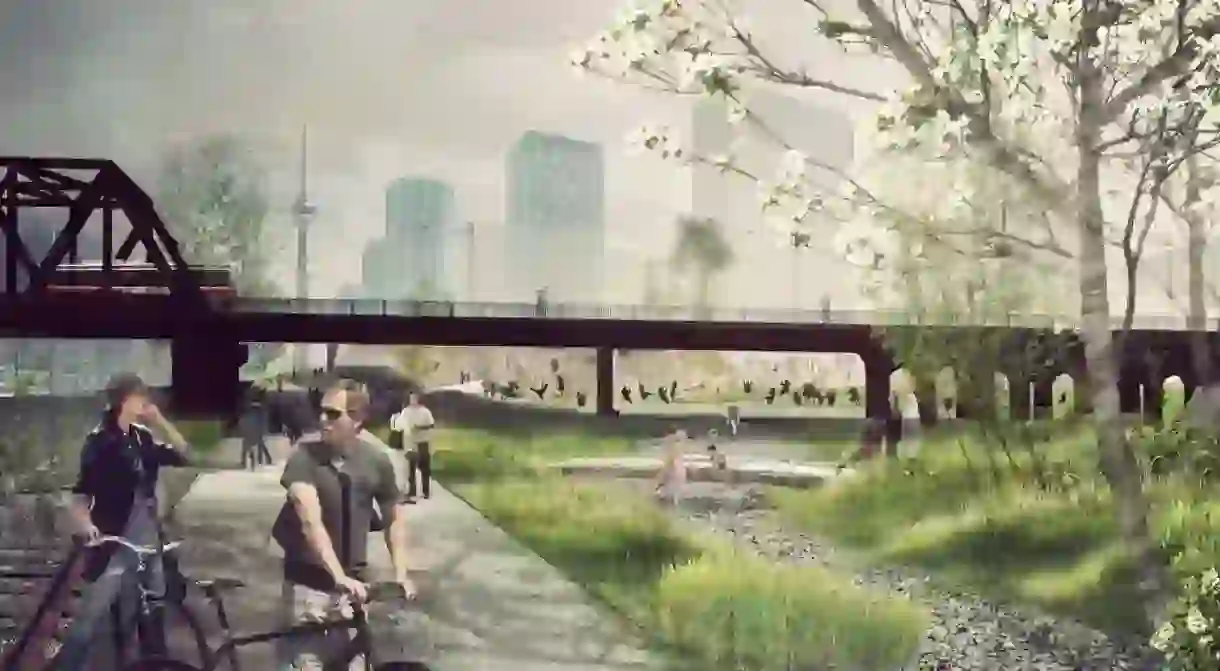What You Need to Know About Toronto’s Upcoming Mouth of the Creek Park

As the urban landscape of Toronto continues to expand rapidly, the city recognizes the need to incorporate more accessible green spaces through the downtown core and beyond. Along these lines, a new project is in place for the creation of a new park that will not only connect different neighborhoods in the downtown area via a green network but will also recall the history of the area and its original natural landscape. Here’s what you need to know about Toronto’s new proposed Mouth of the Creek Park.
Buried rivers and creeks are a part of the story of Toronto’s urban development, often called the lost or “hidden rivers” of the ancient ecology that the city has irrevocably altered while also being deeply embedded within it. You can even take walking tours of the dozens of rivers that have been filled in and almost forgotten about over the course of the past century and a half.

One of the rivers that still remains in the city’s recent historical memory is Garrison Creek, the mouth of which was once situated at what is now the intersection of Bathurst Street and Fort York Boulevard. This location was originally where the river opened out and flowed into Lake Ontario, but today, lake-fill has pushed the waterfront further southward. At the time of European settlement in the late 1700s, however, the natural geography at the mouth of the creek formed a prime location for marine defense. As a result, this became the setting of the city’s first outpost at Fort York, which ultimately led to the founding of Toronto in the safeguarded harbor located east of the fort.
Since being buried, the former mouth of Garrison Creek has largely been an industrial site. In recent years, though, the area has turned into an expanding mixed-use area. With a new block of condominiums under construction, along with the Toronto Public Library’s 99th branch, a dynamic new park is also being planned for the district. The design of Mouth of the Creek Park is a collaboration between the landscape architecture company Public Work and E.R.A Architects, with the intention of creating a community hub for the developing CityPlace neighborhood that also extends the historico-cultural significance of the Fort York National Historic Site and re-activates an important heritage landscape of Toronto.

In this way, Mouth of the Creek Park will connect the southern wall of the nearby rail corridor and pass through the area beneath the 110-year-old steel bridge that conveys north-south traffic along Bathurst Street. The bridge will also feature a new east-west multi-purpose cycling and walking path that will be separated from north-south traffic. In turn, this trail will connect the SkyDome area and other more easterly points through CityPlace to Mouth of the Creek Park, Fort York, and the western waterfront recreational areas. It will also link the forthcoming Fort York Pedestrian Bridges to the neighborhoods of Garrison Point, Liberty Village, and King West.
The park will be around two acres in size, and what makes it unique is its proposed dynamic design. The park, intended to reflect the original landscape of the area, will have an open space under the Bathurst Street Bridge, and there will be three distinct landscapes within the park. First, Panorama Lookout will offer what the designers call “a living history of Toronto,” with an open view facing toward Fort York and the lake even as the ever-expanding urban skyline towers above.

Next, the Garrison Lowlands will reflect the ancient presence of the creek itself through the growth of marsh-like vegetation, a limestone shingle beach, and archeological features that will be re-envisioned as children’s play structures. And finally, the embankment, which will connect the upper and lower areas of the park, will also “allow visitors to come face to face with a dramatic landscape feature that recalls the original shoreline,” according to the designers.

Although the proposed park will be relatively small compared to large urban greening mega-projects like the 8.5-hectare Rail Deck Park proposal, Mouth of the Creek Park will be vital in creating linkages between the city’s districts that are currently disconnected and will help to strengthen the network of Toronto’s accessible green spaces. The project is expected to be completed in 2019.













